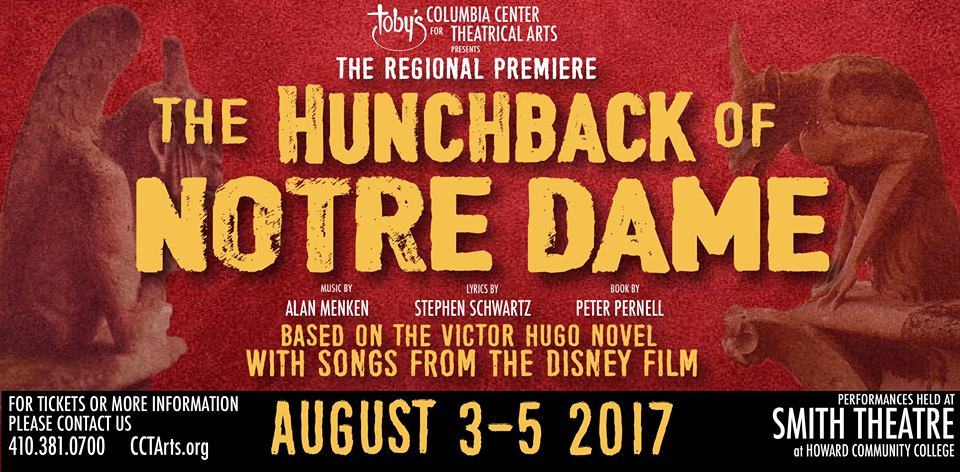Now, here is a riddle to guess, if you can— hear the bells of Notre Dame! What makes a monster and what makes a man? Sing the bells…bells…bells…of Notre Dame! You’ll only discover the answer to this mystifying riddle in the stunning, stirring, brilliant, and breathtaking production of Disney’s The Hunchback of Notre Dame at Columbia Center for Theatrical Arts’ Teen Professional Theatre this summer. Directed by Stephen Fleming with Musical Direction by Ross Scott Rawlings and Choreography by Mark Minnick, this chilling Disney tale— based on the novel by Victor Hugo, with music by Alan Menken, Lyrics by Stephen Schwartz, and book by Peter Parnell— is arguably one of the most moving musicals on the stage in our modern day existence. With breathtaking music, stirring emotional moments, stunning projection effects to accent the simplicity of the production design, and brilliant young talent showcasing all of these components, The Hunchback of Notre Dame, as performed by these Young Columbians, will leave you speechless.
Masterfully conceptualized, Director Stephen Fleming takes this Disney tale, which is remarkably told in earnest compared to most of Disney’s musical stage adaptations (given that they’ve cut the gimmicky sidekick characters that theatergoers might remember from the 1996 film, like the pithy singing gargoyle trio and the stubborn pet goat, put a sincere, albeit dark, spin on the narrative, and drastically changed the ending), and places it center stage in the spotlight of success. Choosing to approach the show from a sleek and crisp minimalist standpoint, Fleming draws the focal point of the show to the story itself, which is remarkably crafted in Peter Parnell’s book and even more impressive once it falls to the voices of these talented young teen performers.
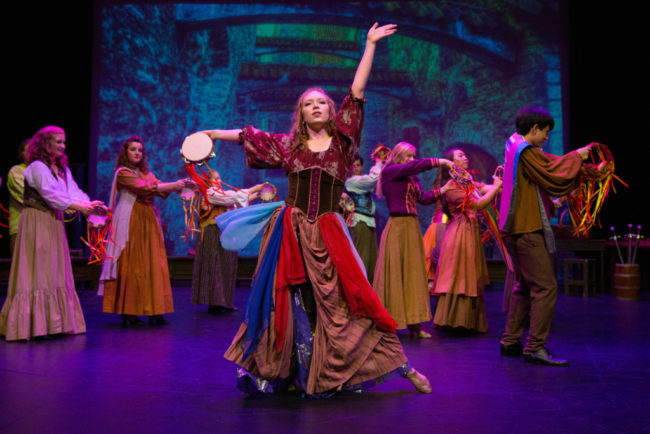
Fleming, who works with Properties Mistress Amy Kaplan and Lighting Designer Eric Moore to fortify his vision, creates a cohesive working space atop the turn table— using it judiciously and wisely— to ease the scenic transitions throughout the performance. What takes this show above and beyond impressive from a technical standpoint are the projections— also designed by Fleming— to enhance the experience. With a subtle shift across the background scrim, the outside of the majestic Notre Dame Cathedral becomes the hallowed insides. Watching the bells peel back and forth across that screen when they are ringing is something of sublime beauty. But further still, Fleming exercises his creativity by incorporating special effects— like smoking flash-pots for quick gypsy escapes— into the motion of the projection. Clean and unfettered from technical delay, these projections are of a striking quality and simultaneously pull you into 15th Century Paris while pushing your attention to the performers.
Properties Mistress Amy Kaplan makes scenic wonders throughout the performance, often enhanced by Eric Moore’s lighting plots. When the narrative shifts to the dark of night, so too does Moore’s focal lighting, creating an eerie atmosphere. This allows for a chill of suspense to creep into scenes— like the one where Quasimodo and Phoebus attempt to find The Court of Miracles— without overcomplicating the scenery. Augmenting these moments with her clever approach to props, Kaplan builds bridges out of bar stools, executing their existence and instant disappearance by having members of the Congregation (Carolyn Becker, Morganne Chu, Felicity Davis, Andrew Fleming, Emma Higgins, Caitlyn Keller, AJ Patel, Diana Rach, Linda Roby, Emily Smith, Nick Walsh, Theodore Yu) hold them above their heads. Kaplan uses these same stools to construct the pyre outside of Notre Dame when it comes time to burn traitors at the stake.
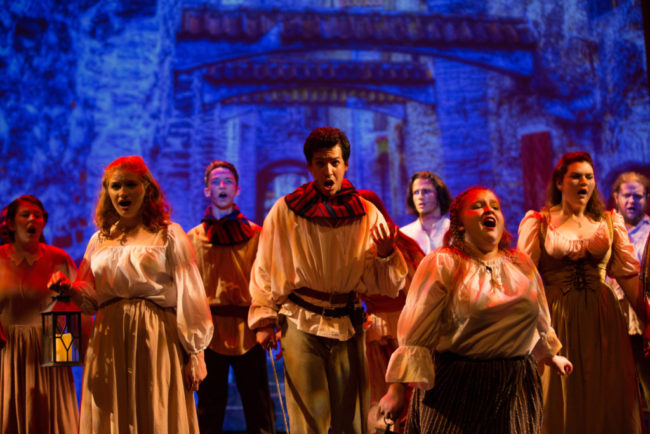
Falling in line with the simplistic beauty of the show’s aesthetic, Costume Designer Lawrence B. Munsey makes the highly intelligent decision to keep those members of the Congregation who perform as stone statues (be they gargoyles or statuary of saints) in their peasant villager outfits rather than outfitting them in a manner that would blatantly buy into the gimmick of anthropomorphism. This strengthens the presence of these actors’ performances and grounds them in harrowing emotions, particularly when they sing their final number “Made of Stone.” That being said, Munsey does take one statue— that of Saint Aphrodisius (Luis “Matty” Montes), whose appearance at the top of Act II in “Flight Into Egypt” is critical to the plot— and outfit him fully in regal robes, complete with the most astonishing accented theatre trick, enabling the performer to appear as the beheaded saint, walking and carrying his own head. Munsey enlivens the sartorial selection for the show on the hole by drawing drastic contrast between the colorful and sprightly skirts, vests, and other festive garments features on the gypsies and the dour, dull, and neutral tones featured on the Cathedral guards, ordinary villagers, and those that reside within the walls of Notre Dame.
Though Menken, Schwartz, and Parnell have— in a sense— matured The Hunchback of Notre Dame (making it comparable to a Les Miserables-type tale filtered through the lens of Disney in the sense of its storytelling purity), the story arc of the narrative follows the animated classic to the letter, with fulfilling additions, right up until the ending. Fear of spoiling such a brilliant piece of musical theatre prevents further detailing of such changes, but it should be noted that the production’s ending much more readily aligns with the history that Victor Hugo captured in his novel, in a humbling and yet evocative fashion.
That said, there is much merriment to look for in the production, including a great many rich opportunities for Choreographer Mark Minnick to put his signature enthusiasm into the show. Minnick’s approach aligns heartily with Fleming’s vision, which is overseen by Artistic Director Toby Orenstein. There is a simplicity to his work; the dance routines are clean, effective, and clear-cut, yet possess an element of fun, fantasy, and that undeniable Disney magic. The most breathtaking feature witnessed in Minnick’s choreography for this show is the way he transforms an ordinary moment into an extraordinary one. Rather than featuring an actual Maypole with the trappings and calamity of its ribbons and sheer bulk for the Festival of Fools scene, the number “Topsy Turvy” features a marching pinwheel, comprised of gypsy ensemblists, who then hoist Clopin atop their shoulders, effectively making him the center of the Maypole. The synchronicity with which this move is executed is striking and the overall visual effect is indeed breathtaking.
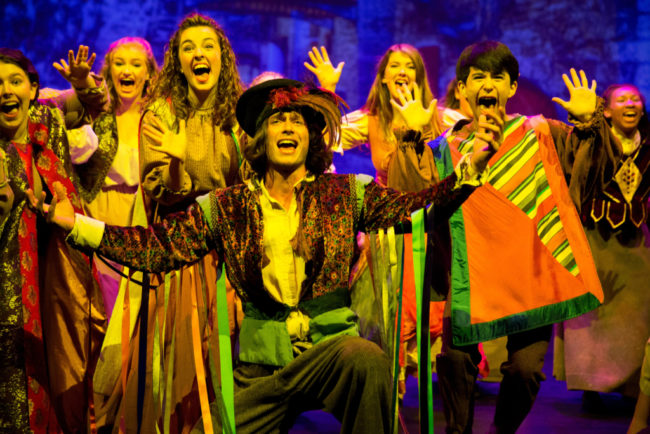
Augmenting the ensemble, under the precision command of Musical Director Ross Scott Rawlings and Vocal Coach Alyson Moore Shirk, a Choir of seven performers (including Shirk herself)— Stephen Forman, Tracy Howse, Samantha McEwen Deininger, Stephen Deininger, Andrew Rayo, and Scott Sauers, add depth to the rich sound of the Congregation from an unseen location offstage. Blending these voices flawlessly into the throng of talented sounds amid the highly complex and intricate music featured in this show is no small task, but it is a task that Rawlings tackles directly and with rigorous success.
Delightfully fleshed out into a fulfilling and deeply satisfying tale, Peter Parnell’s book now includes a richly developed backstory for Quasimodo’s beginning as well as Dom Claude Frollo’s past. This includes the creation of Jehan Frollo (Luis “Matty” Montes), the younger brother to the pious Claude, and the gypsy Florika (Emma Higgins), a wayward temptress. Though Higgins is featured briefly in the opening narrative “The Bells of Notre Dame”, her presence is not soon forgotten. Montes, whose voice is as melodic as the bells of the cathedral themselves, develops a multifaceted character out of Jehan, earning great sympathy and empathy from the audience early on. Appearing in the second act as Saint Aphrodisius, Montes’ extraordinary voice once again rings clear through “Flight Into Egypt”; each passionate note carries a soulful truth and astonishing emotional intent.
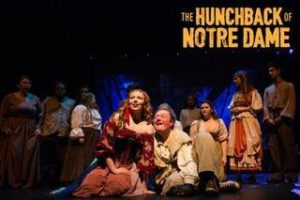
Spirited, fiery, and every bit the wild gypsy woman she initially painted out to be, Cassie Saunders as Esmeralda is a solid choice for this production. Her voice readily carries the iconic “God Help the Outcasts” and with fantastical emotional breadth. Balancing the truculent nature of her character against the more tender and maternal side of her instincts, which are raised instantaneously when it comes to Quasimodo, Saunders delivers a fully developed, multidimensional character, who encompasses so much more than a mere “gypsy distraction.” Talented in the dance department, when she arrives to perform “Rhythm of the Tambourine” there is much of a spectacle to be seen in this number. Watching the chemistry flourish between Saunders and Ray Robinson, playing Phoebus De Martin Captain of the Guard, is one of the more tender and reminiscent parallels to the film.
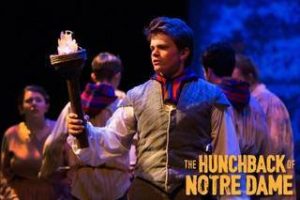
Robinson, as the versatilely charming Captain Phoebus, gives a hearty performance from the moment he stomps into the village with his featured solo “Rest and Recreation.” This number sets the tone for his character, though he quickly changes his tune once encountering Dom Claude Frollo. Though the majority of Robinson’s singing happens in the second act, his presence is heavy and fully experienced in the first half of the production. It’s the duets— “Someday” and “In a Place of Miracles”— where Robinson’s voice shines radiant and his emotional connection to the character becomes apparent. These numbers, performed with Saunders, are tender, heartfelt, and truly touching, giving a deeply introspective look into the development of Phoebus and how his story ultimately ends.
Make way for the King of Fools! The master of the gypsies, the weaver of the story, Clopin Trouillefou (Joshua Huff-Edsall) is a sensationally matured version of the comic device that he is in the film. Huff-Edsall embodies the playful spirit of Clopin without making him too childish or silly in a manner that would fall outside the realm of reality for the stage musical. Possessing a keen sense of balance when it comes to humor, Huff-Edsall accelerates the cheeky and charming facets of the Clopin character while keeping him realistic, a human being— albeit a tricky one— rather than a gimmicky puppet. Sliding seamlessly in and out of the character, who ignites the show as the principal narrative figure, Huff-Edsall’s superb voice is exceptionally well suited for the glistening radiance of “The Bells of Notre Dame” but versatile enough to incite excitement and jubilation with much rousing and merriment for “Topsy Turvy.” Fully traversing the gamut of his own dynamism, Huff-Edsall showcases yet another side of the Clopin character during “The Court of Miracles”, never losing sense of his position and rank among the gypsies, while simultaneously engaging in a part of the story that only his character can play.
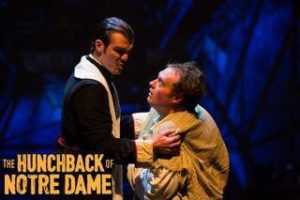
There is an ill-fated and unsavory ease that accompanies Dom Claude Frollo (Brian Nabors) onto the stage from the beginning of the performance straight through to the end. Nabors, as the brutally antagonistic man of the cloth, is ruthless in his pursuit of religious purity. With a flawless vocal sound, numbers like “Sanctuary” and his dual reprises of “Esmeralda” become unnervingly delectable. The rich timbre of his voice slips through these numbers like that of a fallen angel, dark and seductive, sending shivers up the spine. Delivering a bone-chilling rendition of “Hellfire”, Nabors all but stops the show with the final note of this number; the experience of this song on the whole feels driven by an unholy demon that has seized possession of his conscious mind, body, and voice making it nearly indescribably perfect. Printed word does not begin to do a fair justice to what Nabors creates in this overzealously pious character, particularly when it comes to the way he layers his interactions with Quasimodo.
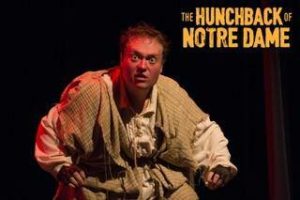
With a performance as pure and as radiant as heaven’s light, Samuel Kobren brings the audience to tears as Quasimodo. Grounded in a painstaking place of honesty, Kobren is so fully invested in the physicality, mentality, emotional state, and vocality of this character that is he, beyond the shadow of a doubt, The Hunchback of Notre Dame. With a vocal affectation that belays Quasimodo’s naiveté and overall ignorance to the world outside the cathedral walls, Kobren immediately fabricates a character deserving of the deepest sympathy and the most passionate empathy. When transitioning into song, Kobren retains enough of this character affectation in his voice to maintain what he has established in his creation of Quasimodo without compromising the musical quality of the song. “Out There” is a passionate embrace of the world he’s never known, a vocal dream of hope and daring. “Heaven’s Light” is yet another example of how emotionally grounded Kobren is in the role, bringing forth a multitude of tumultuous feelings into every note that he sings. From the moment the back half of the second act passes that inevitable point of no return through to the show’s finale, Kobren delivers a performance that is so raw, so heartfelt, and so passionately driven, that it will draw forth perpetual tears for the last 15 minutes of the show. “Made of Stone” is the number where Kobren’s tortured soul melts down and crashes over the audience, drowning them in a plethora of pathos that defy logical description. And when he falls into the intensely driving moments of “Finale Ultimo” with the signature cry of “Sanctuary! Sanctuary!” there is such heart and soul behind it that if one isn’t crying already, it will move you to tears.
A stunning and phenomenal production, not only in its construction, conception, and execution, but also in its performance from these extraordinarily talented young performers, there is nothing in world like The Hunchback of Notre Dame as performed by the Teen Professional Theatre of Columbia Center for Theatrical Arts.
Running Time: Approximately 2 hours and 30 minutes with one intermission
The Hunchback of Notre Dame plays through August 5, 2017 as the Teen Professional Theatre’s summer production with the Columbia Center for Theatrical Arts in the Horowitz Center Smith Theatre on the Howard Community College campus— 10901 Little Patuxent Parkway in Columbia, MD. Tickets are available for purchase online.

